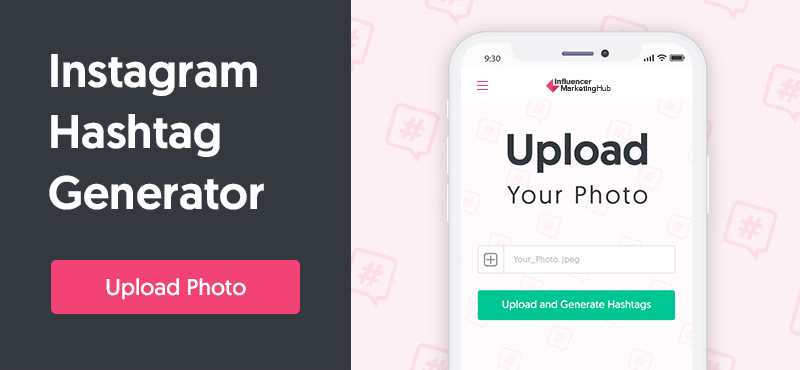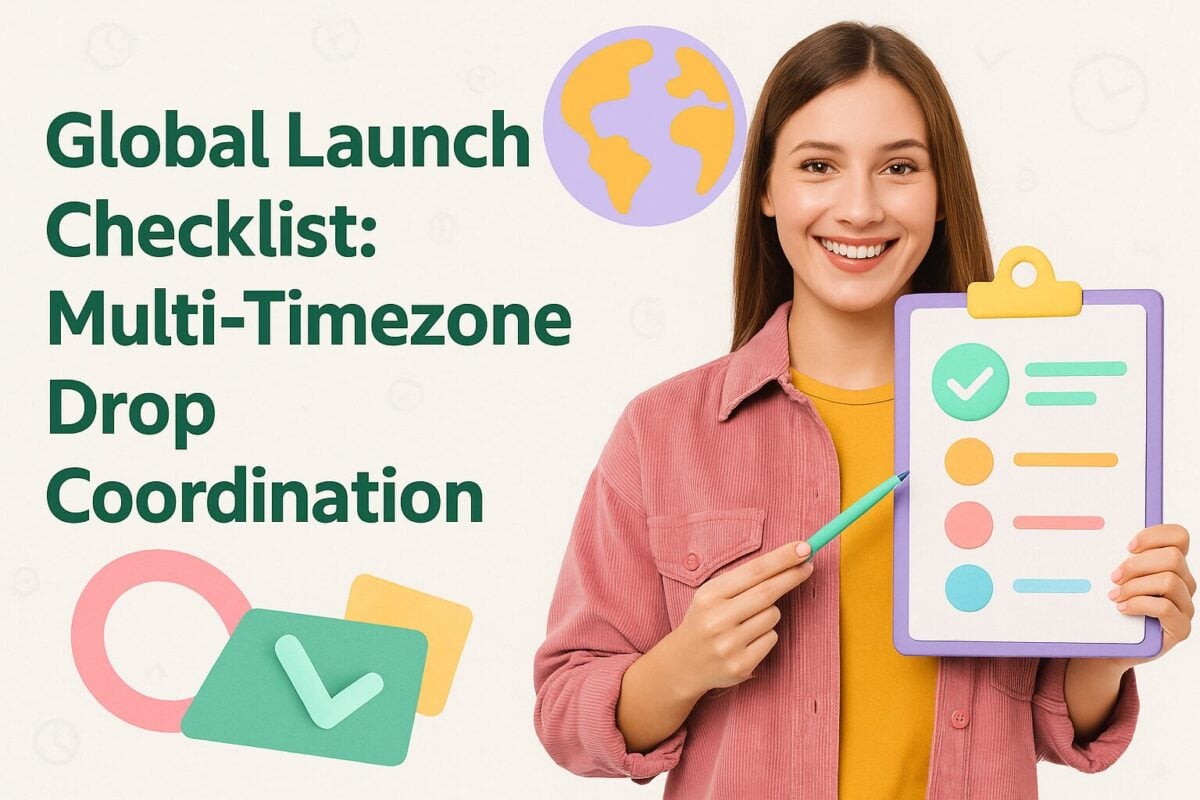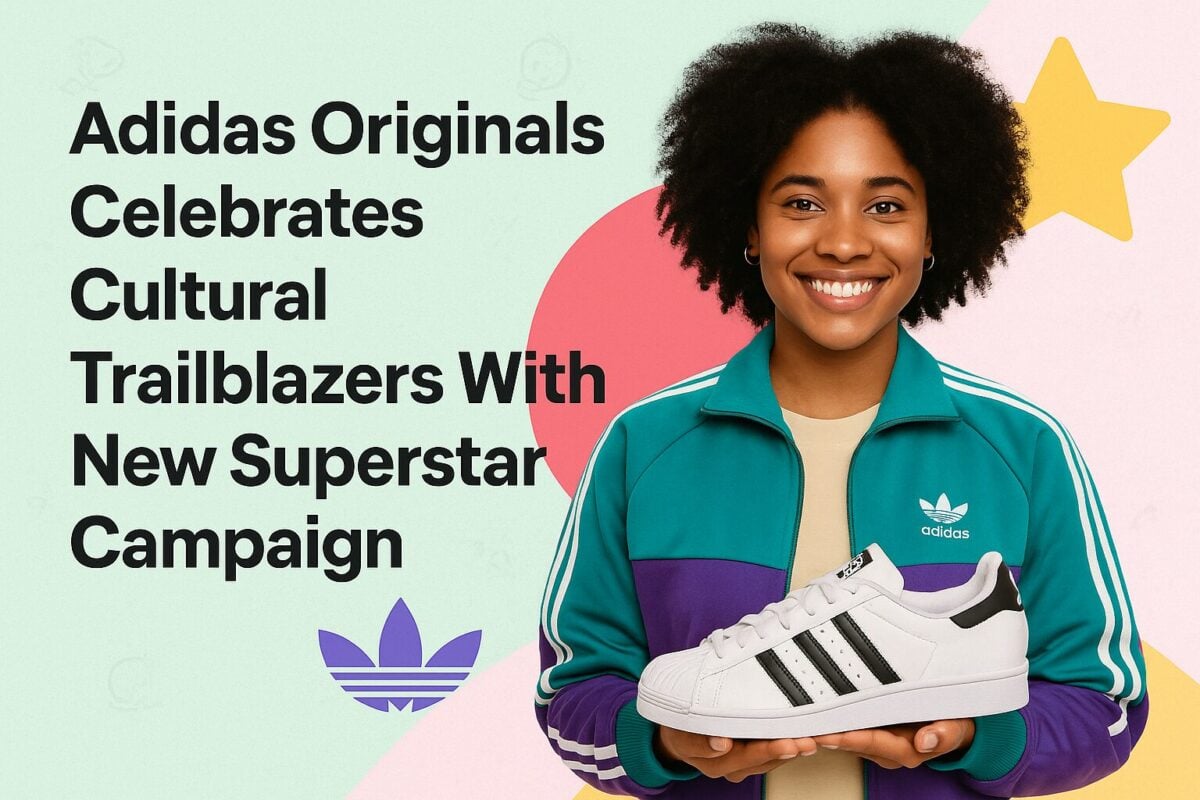The idea of using hashtags to grow your followers on Instagram seems to lead to one of two polarizing views. You either love to spread hashtags throughout all of your posts, or you hate using them, avoiding them like the plague. The fact remains, though, that hashtags generally help you widen the spread of your posts.
Instagram is tailor-made for hashtag usage. In fact, hashtags are arguably Instagram’s primary method of sorting and filtering content. Unlike Twitter, where most people use just one or two hashtags in a tweet, Instagrammers frequently use most of their allowance of 30 hashtags in each post.
But just because you can use 30 hashtags in a post does not mean that you should. There is no value in using irrelevant hashtags just to make up a hashtag quota. The key to Instagram hashtag usage is to include plenty of relevant hashtags that will help your fellow Instagrammers. If you use unrelated hashtags, you are spamming the system and placing yourself in danger of receiving an Instagram shadowban.
- How to Use Instagram Hashtags
- Benefits of Adding Hashtags to Your Instagram Posts
- Types of Hashtags You Should Use on Instagram
- Finding the Right Hashtags for Your Posts
- Most Popular Instagram Hashtags in 2024
- Use Social Media Tools to Find the Best Hashtags
- Use Hashtags In Your Bio
- Add Hashtags to Your Instagram Stories
- Special Types of Instagram Hashtag
- Track the Success of Your Instagram Hashtags
- Frequently Asked Questions
How to Use Instagram Hashtags
Hashtags are a powerful tool for increasing your Instagram reach, but using them strategically is key to driving engagement and growing your audience. Simply adding random hashtags isn’t enough. You need a well-thought-out approach to ensure your content gets discovered by the right people.
Here’s a detailed guide on how to optimize your Instagram hashtag strategy:
Research Relevant and Popular Hashtags for Your Niche
Start by identifying hashtags that align with your content, industry, and audience. A good practice is to explore what hashtags competitors or industry leaders are using. Additionally, you can use Instagram’s search function to find trending hashtags and related terms that might boost your post's visibility.
Use a combination of broad and niche hashtags. Broad hashtags like #travel or #food can increase your exposure to a wide audience, but they also come with more competition. Niche hashtags, such as #solotraveler or #veganfoodie, target a more specific and engaged audience.
For instance, if you're a Chicago-based photographer, using both #photography and #chicagophotography allows you to reach different segments of Instagram users.
Strategically Place Hashtags
You can place hashtags either in your post caption or in the first comment. Both methods are effective, but the choice depends on how clean you want your caption to look. Placing hashtags in the caption can help users discover your content immediately while using the first comment keeps your caption aesthetically simple.
Suggestion
Experiment with both placements to see which yields better engagement for your posts.
Limit Your Hashtags to Boost Engagement
While Instagram allows up to 30 hashtags per post, using the maximum amount isn’t always necessary. In fact, overloading your post with too many hashtags can sometimes make it appear spammy.
Aim to use 3-5 highly relevant hashtags, ensuring a balance between broad and specific terms. This can often result in better engagement and more targeted exposure. Be mindful of experimenting with different combinations of hashtags to find the right mix for your audience.
Regularly Monitor and Adjust Your Hashtag Strategy
Monitoring your hashtag performance is crucial for optimizing your Instagram strategy. Instagram’s analytics tools allow you to track how specific hashtags contribute to the reach, impressions, and engagement of your posts.
Based on this data, you can fine-tune your approach by using hashtags that consistently perform well and eliminating those that don't. This continuous refinement can help you maintain and increase visibility over time.
Benefits of Adding Hashtags to Your Instagram Posts
Incorporating hashtags into your Instagram posts can significantly boost your social media strategy. Here are some key benefits of using hashtags effectively:
Increases Visibility and Discoverability
Hashtags expand your post’s reach beyond your followers, making your content discoverable to a broader audience. When you use relevant and popular hashtags, you increase the likelihood of attracting new followers and engaging with potential customers. This visibility allows you to tap into conversations that align with your brand, giving your content a better chance of being seen by the right people.
Boosts Engagement
Hashtags encourage users to interact with your content. By connecting with people searching for similar topics, hashtags can lead to more likes, comments, and shares, ultimately improving your post’s performance. The more engagement your post receives, the higher its chances of being prioritized in Instagram’s algorithm, which can further extend your reach.
Enhances Brand Awareness
Branded hashtags help reinforce your identity and encourage users to participate in conversations around your brand. They provide a way for users to connect with your content and contribute to your brand’s online presence. When users engage with your branded hashtags, it fosters a sense of community and brand loyalty, turning casual viewers into dedicated followers or even advocates.
Facilitates Competitor Analysis
Hashtags also serve as a useful tool for analyzing your competitors' strategies. By observing which hashtags they use, you can gather insights into industry trends and discover ways to refine your own approach. This kind of competitor research can help you stay relevant in your niche, allowing you to pivot your strategy as needed to stay ahead of the curve.
Supports Content Research
Monitoring hashtag performance helps you understand which topics resonate with your audience. This insight allows you to tailor your content to meet their interests and optimize your future posts for maximum impact. Additionally, hashtags can help you identify emerging trends or new content ideas that might engage your audience more effectively.
Types of Hashtags You Should Use on Instagram
You'll want to use and track various types of hashtags for a successful hashtag marketing strategy. Let's look at the types of Instagram hashtags you can use:
Use Popular Hashtags to Increase Your Views
As I recently discussed in The Most Popular Instagram Hashtags on the Planet, there are quite a few hashtags that receive regular use. The most popular tags may have too much use, however, meaning your posts would get lost in the crowd. But there are still many loved hashtags that are used a more manageable number of times.
Your posts will end up in the search results of people who search for the hashtags you use.
A recent change in Instagram, allows people to follow selected hashtags, which should further increase the reach of your posts that use those hashtags.
Often people looking at a particular hashtag will come across your post. If they like it, they may even begin to follow your Instagram account in the hope of seeing you produce further similar content.
Of course, there is the usual caveat. There is no use using a popular but irrelevant hashtag. You might, for instance, have noticed that #summer is a popular hashtag right now. You could use it on any post that evoked summer in some way.
But it would not be suitable to include on the photos of your friends snowboarding. Similarly, #selfie is popular, but you wouldn't use it on your picture of a beautiful landscape.
Use Highly Specific Hashtags to Reach Your Ideal Audience
You should also include a selection of low-volume, highly relevant, hashtags in your posts. There may not be vast numbers of people following these hashtags, but you know that the people who do take an interest in them will make a perfect match for your account.
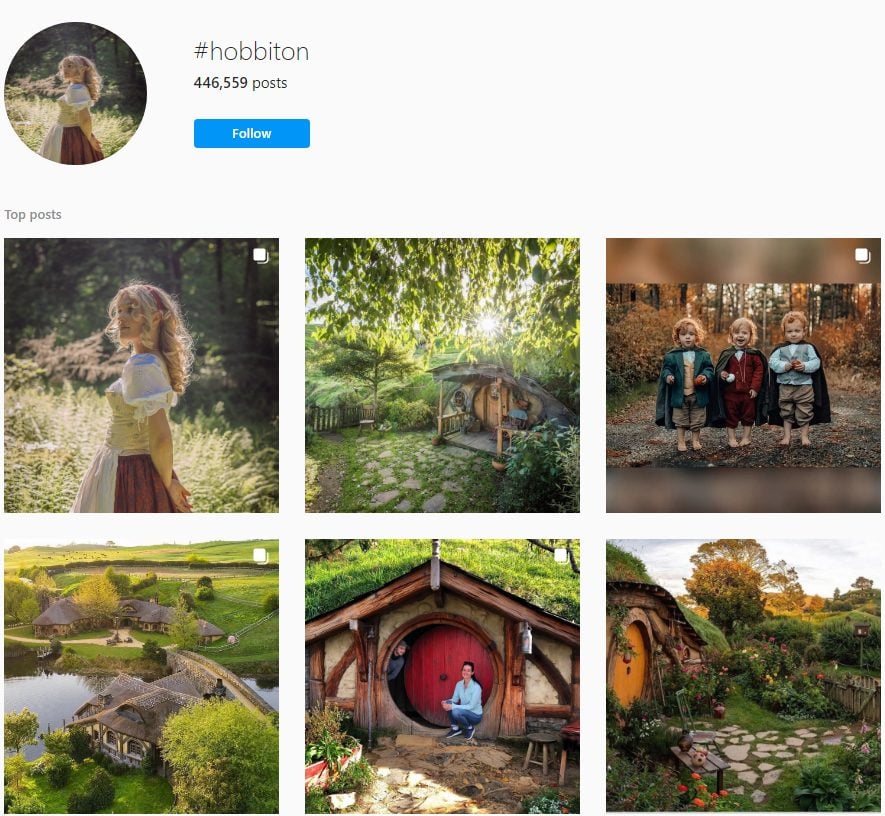
Source: instagram.com
So, if you are a Lord of the Rings fan, by all means, use #hobbiton on your Lord of the Rings posts – 446,559 people; have already done so. It is highly likely that anybody who searches that hashtag will take an interest in your LOTR-related posts. Of course, you should also use #lotr and join the existing 1,812,932 posts.
Depending on what your post depicts, you would use a relevant generic hashtag, and then break the topic down into more specific hashtags, too. For instance, you might use the trendy #food tag, but you should also consider using more specific food-related tags, such as #foodlove, #dinnertime, #dessert or perhaps even more niche.
With that said, there are specific types of hashtags on Instagram. Those are:
- Branded Hashtags
- Content Hashtags
- Event Hashtags
- Trending Hashtags
More on these types of hashtags later on.
Finding the Right Hashtags for Your Posts
The thought of using up to 30 hashtags per post may initially appear mind-boggling. This is particularly so when you realize you can’t just use the same block of hashtags on every post. If you post regularly to your Instagram account, you need to build up an extensive library of hashtags to use. You need to select the most appropriate group for each post you make.
Ways you can find suitable hashtags include:
- Use the Instagram search function. Type in a keyword relevant to your post and select the Tags tab. Instagram will then ist a range of hashtags. Look for relevant tags with a reasonable usage that are not so popular that your posts will quickly disappear.
- Use the hashtags that the influencers in your industry use.
- Look at your competitors’ posts and use the non-branded tags that they use. Check their posts to ensure that the hashtags are not part of one of their campaigns before you use them, however.
- Look at posts that use hashtags you have found successful. What other hashtags do these posts target? Would any of these tags be valuable to your brand?
Most Popular Instagram Hashtags in 2024
Here are the most popular Instagram hashtags in various categories for 2024, along with their usage counts:
Top 20 Instagram Hashtags in 2024
- #love (2.1B posts)
- #instagood (1.6B posts)
- #fashion (1.1B posts)
- #photooftheday (1B posts)
- #picoftheday (771M posts)
- #beautiful (795M posts)
- #happy (716M posts)
- #cute (685M posts)
- #tbt (600M posts)
- #art (598M posts)
- #nature (598M posts)
- #repost (560M posts)
- #summer (500M posts)
- #style (470M posts)
- #instadaily (460M posts)
- #selfie (450M posts)
- #reels (430M posts)
- #fitness (420M posts)
- #travel (400M posts)
- #food (350M posts)
Top 10 B2B Instagram Hashtags
- #B2B (5M posts)
- #business (450M posts)
- #B2Bmarketing (1M posts)
- #digitalmarketing (200M posts)
- #businessgrowth (180M posts)
- #leadgeneration (1M posts)
- #businessstrategy (80M posts)
- #entrepreneurlife (200M posts)
- #contentmarketing (90M posts)
- #smallbusiness (80M posts)
Top 10 Fashion and Beauty Instagram Hashtags
- #fashion (1.1B posts)
- #ootd (444M posts)
- #style (470M posts)
- #makeup (400M posts)
- #beauty (350M posts)
- #skincare (90M posts)
- #fashionblogger (200M posts)
- #fashionista (100M posts)
- #model (250M posts)
- #hairstyle (300M posts)
Top 10 Fitness Instagram Hashtags
- #fitness (420M posts)
- #workout (300M posts)
- #fit (200M posts)
- #gymlife (100M posts)
- #motivation (400M posts)
- #fitnessmotivation (350M posts)
- #gym (200M posts)
- #healthylifestyle (190M posts)
- #fitfam (100M posts)
- #personaltrainer (120M posts)
Top 10 Travel Instagram Hashtags
- #travel (400M posts)
- #wanderlust (154M posts)
- #travelphotography (244M posts)
- #travelblogger (90M posts)
- #adventure (152M posts)
- #travellife (18M posts)
- #explorenature (1M posts)
- #landscapephotography (50M posts)
- #vacation (200M posts)
- #travelgram (3M posts)
Top 10 Lifestyle Instagram Hashtags
- #lifestyle (450M posts)
- #inspiration (250M posts)
- #selfcare (200M posts)
- #motivation (400M posts)
- #mindfulness (90M posts)
- #dailyinspiration (20M posts)
- #liveauthentic (50M posts)
- #wellness (100M posts)
- #happiness (90M posts)
- #simpleliving (10M posts)
Use Social Media Tools to Find the Best Hashtags
You might consider finding appropriate hashtags to be a daunting and uninviting task – one that potentially takes the fun out of your Instagram usage. Luckily there are quite a few software solutions to make the job more straightforward for you.
In time you should be able to create a personal library of hashtags from which you can pick and choose each time you assemble a post.
1. Instagram Hashtag Generator
The Instagram Hashtag Generator - created by ourselves here at Influencer Marketing Hub. The tool uses AI image recognition technology to identify popular and trending hashtags on Instagram.
It is very easy to use: You upload your Instagram photo and the tool will generate the most popular niche hashtags for your Instagram Post. Then you can select the best hashtags, copy them in bulk, and paste them into your Instagram photo caption.
It also works as a Pinterest Hashtag Generator Tool.
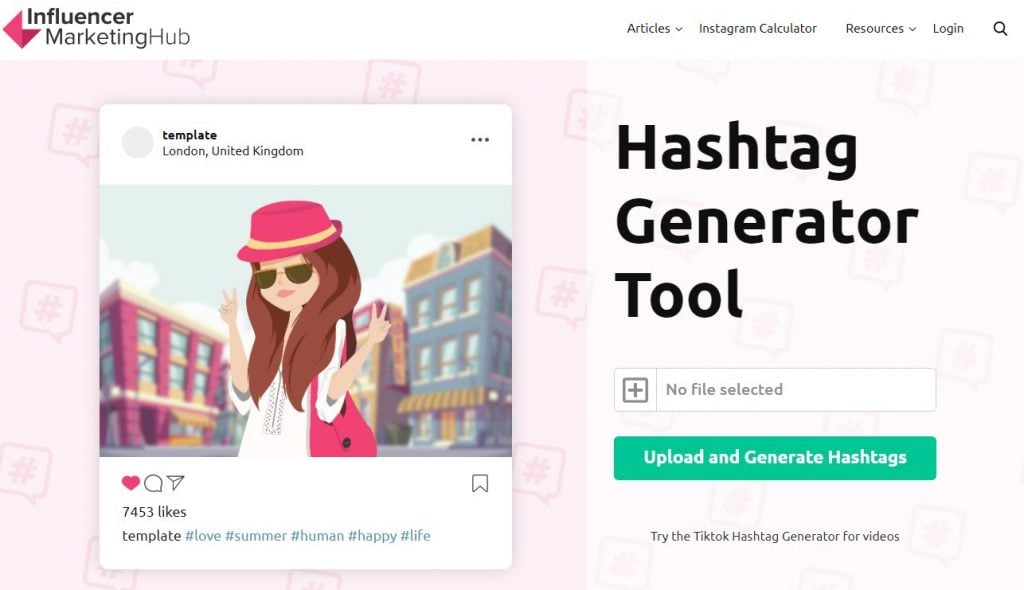
2. Iconsquare
Iconsquare provides a full set of analytics tools for Instagram and Facebook. It gives you a wealth of knowledge about your online following.
It follows a hashtag’s growth across posts, videos, and photos. It can show you the most influential posts relating to a hashtag. It will even visualize where people are posting using your hashtags. It allows you to monitor the engagement relating to the hashtags you use.
3. Hashtagify
You can use Hashtagify to search for hashtag popularity, trends, and correlations. You can enter a suggested hashtag, and Hashtagify scrapes all related data from both Instagram and Twitter. This provides you with a detailed report on users of the hashtag. It will suggest top influencers who use the hashtag, and how their followers engage with the hashtag. It also recommends other relevant hashtags that influencers use.
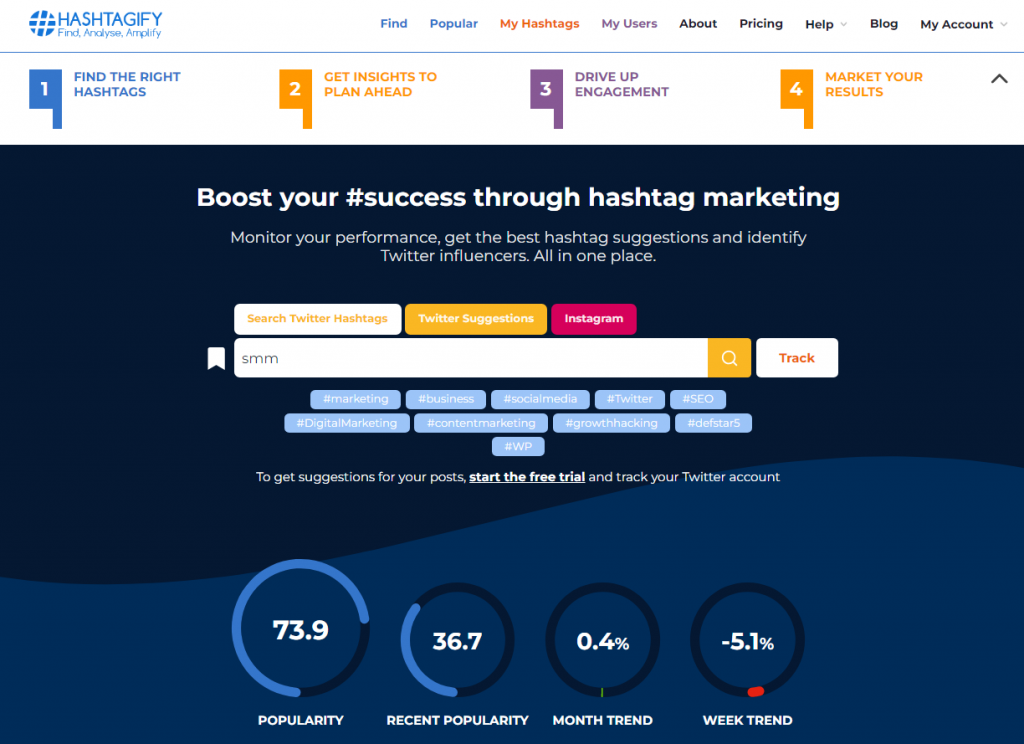
Source: hashtagify.me
You can use Hashtagify to search for and locate trending hashtags, discovering the ones most relevant for your audience
4. Ritetag
Ritetag provides you with numerous hashtag suggestions for any topic of your choice. You can select a hashtag as a starting point, and Ritetag will suggest multiple hashtags that will match. You can use Ritetag to keep up-to-date with hashtag trends.
Ritetag offers a Chrome add-on that suggests suitable hashtags you can use for your posts.
It provides groups of suggested hashtags by topic, making it easy for you to compare. You can also use Ritetag to discover hashtags in a cloud-like cluster.
It color-codes hashtags so you can see whether a particular hashtag is best used to gain followers now, whether it is better used over the longer term, whether it has very little usage, or whether it is so popular that your posts will disappear too rapidly.
Use Hashtags In Your Bio
A recent change to Instagram means that you can now include clickable hashtags in your bio. This gives you an excellent opportunity to create a custom hashtag for your brand, linking to all the posts that use it directly from your bio.
It also means that you could click on hashtags relevant to your brand. For instance, if you are involved in tourism, you could include clickable hashtags in your bio that relate to your city or region.
This could be particularly useful for influencer marketers who could link to specific hashtags for their clients from their bios.
Add Hashtags to Your Instagram Stories
Instagram Stories can be an excellent way to get your message across to your (or your influencers’) Instagram followers. You should include hashtags in your stories to help people discover them.
As with any other Instagram hashtag, those in your Stories are searchable, meaning your Stories will show up in relevant hashtag searches.
Special Types of Instagram Hashtag
Most Instagram hashtags are generic and subject-related. This means that anybody can use them, as long as they relate to the subject matter of the post.
Some hashtags have specific purposes, however.
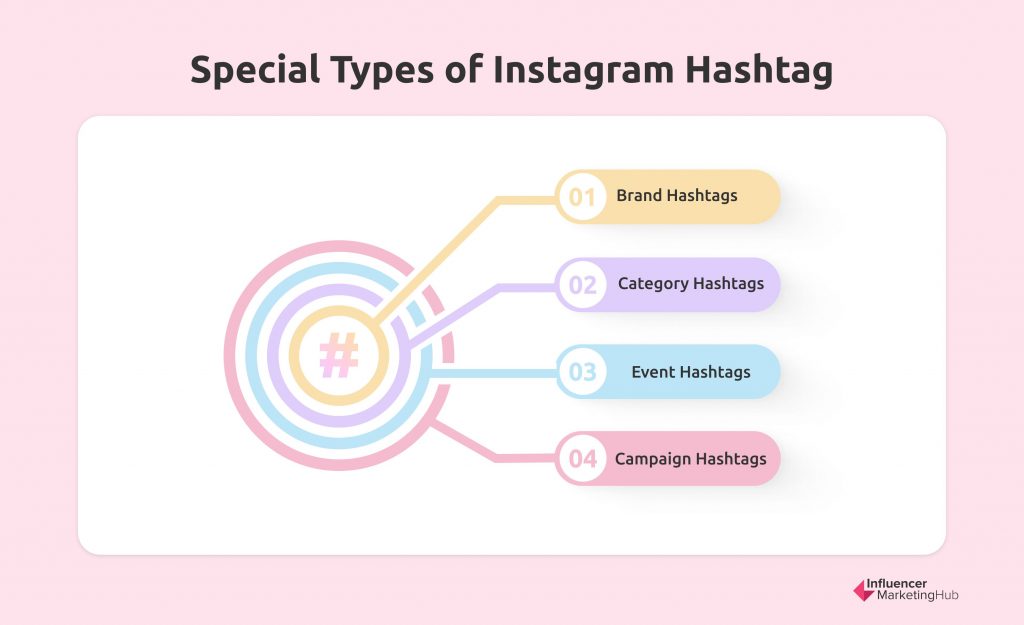
1. Brand Hashtags
Brands often create specific hashtags relating to their products or brand. For example, Coca-Cola encourages people to post pictures of themselves sharing a bottle of their product, using the #shareacoke tag. These are often (but not always) influencers in a paid partnership with Coca-Cola.
In most situations, brand hashtags, work best with people who already know of the brand.
Brands have found that associating a tagline or phrase with the brand works better than trying to use the brand name itself as the hashtag. #shareacoke sounds less promotional than #cocacola. The critical thing is to create a brand hashtag that people can associate with your brand identity.
You often use branded hashtags to connect themes for your audience.
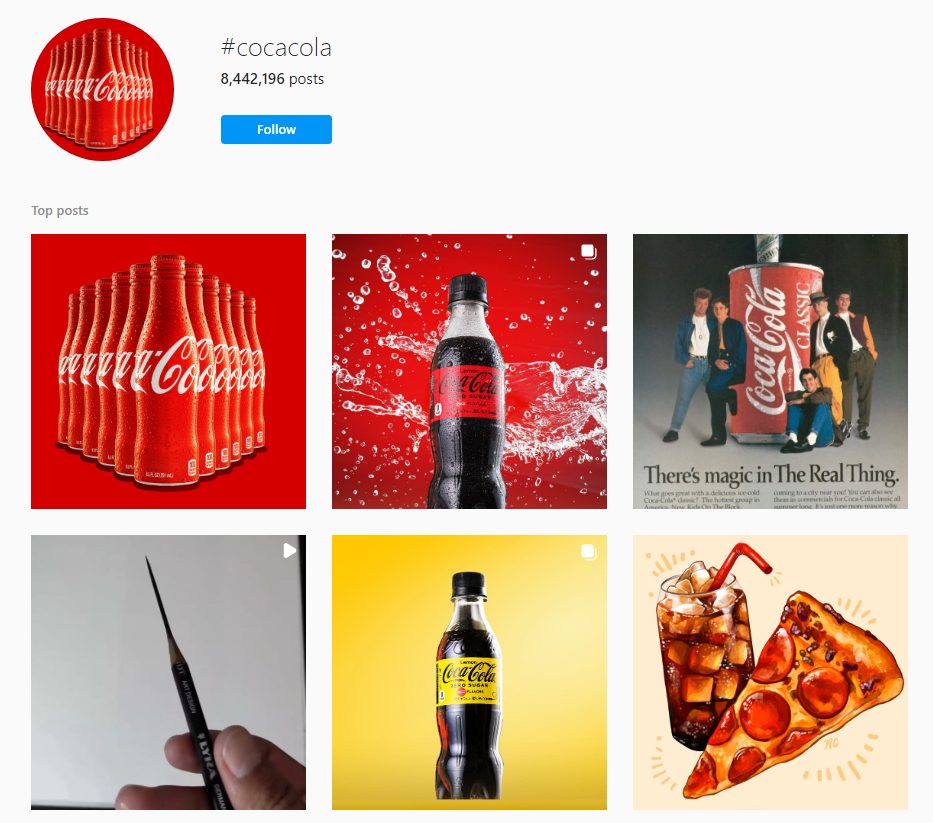
Source: instagram.com
2. Category Hashtags
These can be relatively generic tags, but they relate to the central niche that your post fits into. For instance, if you upload a picture of yourself running the Boston Marathon, you should include some category hashtags, such as #running and #marathon.
Category hashtags will not generally connect to any particular brand. They are much less focused, and it is likely that many people who search for that hashtag will not have an existing connection with you. Often they will not even know of your existence.
For maximum exposure, you will want to balance using a popular category hashtag against using those trendy tags where your posts will become lost in a sea of activity. Ideally, you should search for category hashtags favored by your target market, but not too many other people. You want to use relatively narrow-focused category hashtags, that still have enough engagement to make your efforts worthwhile.

Source: instagram.com
3. Event Hashtags
Event hashtags are used to group conversations relating to a particular event. This could be anything ranging from a specific television show, e.g., #gameofthrones to a major sporting event, e.g., #worldcup, to a regional activity, e.g., #sxsw.
If there is any correlation between an event and your target market, it makes sense to create posts targeting relevant event hashtags.
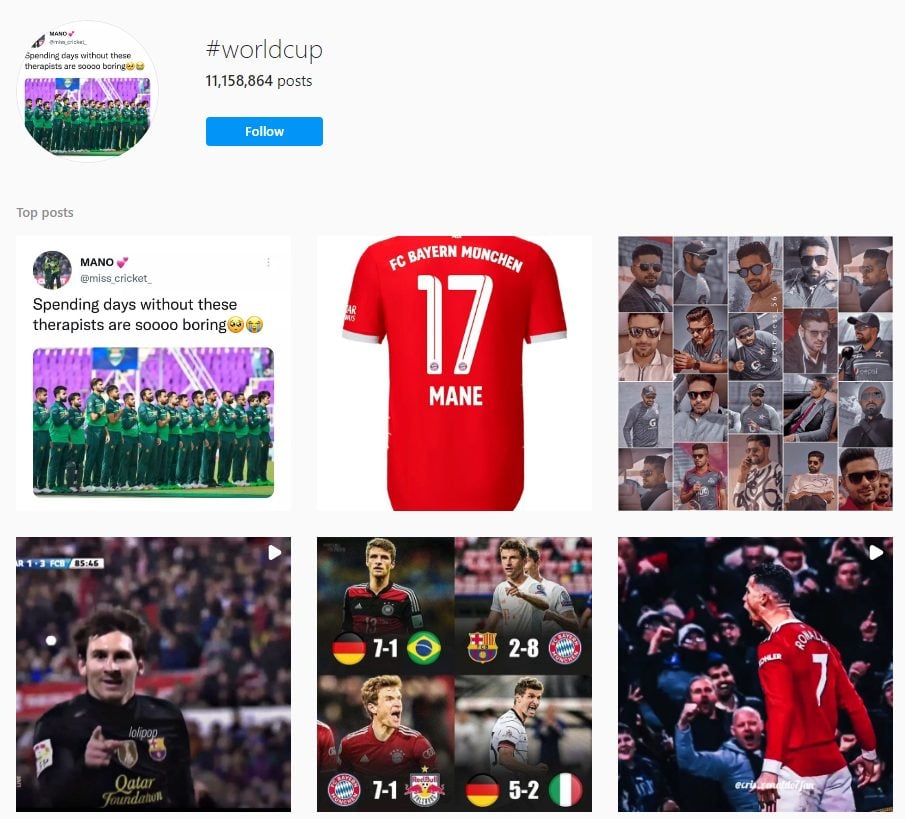
Source: instagram.com
4. Campaign Hashtags
In many ways, campaign hashtags are like short-term brand hashtags. They may even be similar to an event hashtag, but specific to your business.
Campaign hashtags are designed for a particular marketing campaign, and will generally only last for the duration of the campaign. For example, you might create a campaign hashtag to use for a specific product launch. In that case, your brand and any influencers you work with would include the campaign hashtag in promotional posts relating to the launch.

Source: instagram.com
Track the Success of Your Instagram Hashtags
As we referred to in 6 Benefits of an Instagram Business Profile, operating a business profile gives you access to Instagram Insights. This gives serious Instagram users access to analytics and performance statistics far above what they provide to the average Instagrammer.
One useful feature of Instagram Insights is the ability to analyze the effectiveness of the hashtags you use. You can see how successful your hashtags have been at bringing you more views and impressions of your posts.
To see this information, open a post and tap on the “view Insights” link beneath it. Amongst the data that Instagram Insights provides is the impression of the post, split up by source. This includes Impressions from Hashtags.
While this doesn’t tell you the performance of specific hashtags, it does give you a guide to the effectiveness of the overall group of hashtags you used on the post.
Frequently Asked Questions
What are the main benefits of using hashtags on Instagram?
Hashtags increase visibility, boost engagement, enhance brand awareness, and help with content research and competitor analysis.
How many hashtags should I use on Instagram?
While Instagram allows up to 30 hashtags per post, it’s often better to use 3-5 highly relevant ones to avoid appearing spammy.
Where should I place hashtags on Instagram posts?
You can include hashtags in the caption or in the first comment. Both methods work, but placing them in the first comment keeps your caption clean.
What is a branded hashtag?
A branded hashtag is a custom hashtag that incorporates your brand or product name to boost brand awareness and engagement.
How do trending hashtags help my posts?
Trending hashtags increase the chances of your posts being seen by a larger audience, especially when the hashtags are relevant to your content.
Can using irrelevant hashtags harm my account?
Yes, using irrelevant hashtags may lead to decreased engagement and, in some cases, result in an Instagram shadowban, limiting your post's visibility.

